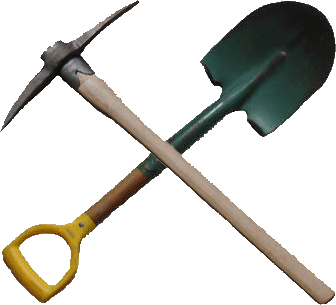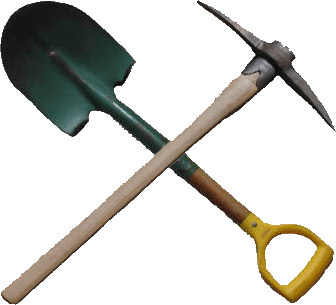|
|
|
Historic Lost Basin/King Tut Placers
|
"...the gold samples held by the USGS from the Lost Dutchman Mine in the Superstition Mountains near Phoenix, Arizona, were identified as being from Lost Basin and they assumed that the Dutchman had obtained the gold samples from Indians at Lost Basin and endeavored to hide this source by fabricating the Superstition Mountain story."
W.E. Dunlop also found the King Tut Placers in 1931. "Here, a gravel-floored plain, from 3,000 to 4,000 feet above sea level, rises southwestward between Grapevine Wash and the base of a low northward trending ridge locally called the Lost Basin Range," according to the Arizona Bureau of Mines' publication, Gold Placers and Placering Arizona, Bulletin 168. The richer gold-bearing gravels occur within an area some eight miles long by an undetermined width and are mostly
composed of slab-shaped schist pebbles. These deposits are generally less than two feet thick and rest upon caliche-cemented gravels. The gold found at the King Tut Placers occurs partly as fine material and partly as flat, rugged nuggets that are known to range up to one-sixteenth of an ounce in weight.
"The King Tut Placers probably originated from erosion of a group of gold-bearing quartz veins in the Lost Basin Range. The ruggedness of the gold nuggets, many of which carry attached quartz, indicates a local derivation," according to the source cited above. Lode gold deposits were discovered and worked in the Lost Basin Range in 1886 and in the Gold Basin area in the 1870's.
In the mid sixties, an entrepreneur, Warren Mallory, spent two years with a geologist exploring the Lost Basin area and recorded placer claims under the name of Apache Oro Co (later transferred to American Heavy Minerals Inc., a Wyoming corporation). During the first few years after recording the claims, Warren Mallory attracted the interest of the U.S. Geological Survey, Department of Interior, who spent several million dollars on a geological and mineral study of the area, producing in 1987 a report published as USGS Professional Paper # 1361 entitled "Geology and Gold Mineralization of the Gold Basin-Lost Basin Mining Districts, Mohave County, Arizona".
Acknowledgement to Warren Mallory is given on page 101 under the statement "Warren Mallory, president of Apache Oro Co. collected specimens with visible gold from many veins and generously donated them to us. He also gave us gold from the King Tut mines, Without his interest and generous support, this work would not have been possible" The Chief Chemist of the USGS (J. Antweiler), who was a co-author of the report, disclosed to Mr. Mallory that gold has a signature (like a fingerprint) that identifies it to a specific area. He stated that the gold samples held by the USGS from the Lost Dutchman Mine in the Superstition Mountains near Phoenix, Arizona, were identified as being from Lost Basin and they assumed that the Dutchman had obtained the gold samples from Indians at Lost Basin and endeavored to hide this source by fabricating the Superstition Mountain story.
The King Tut Mine and the Lost Basin Placers are located south of Meadview, Arizona in Mohave County.

(NationalAdventurer.com)

|
![[Most Recent Quotes from www.kitco.com]](http://www.kitconet.com/charts/metals/gold/t24_au_en_usoz_2.gif)

|
Please visit our other websites:
Desert Drew's RV Roof Systems
Our RV / Trailer / Mobile Home Roof Repair and Roof Seamless Membrane Resurfacing Business
NationalAdventurer.com
Our Full-Time Off-Grid RV Adventure Blog
(currently undergoing revison)
MojaveWindToys.com
Kites, Line Laundry, Wind Spinners, Yard Art, Toys and More!
(currently undergoing revison)
Time4u2Fly.com
Ultralight Trikes, Paragliding (PG), Speedflying, Powered Paragliding (PPG) and Other Ultralight Aircraft Info
(currently undergoing revison)
|
|
|





